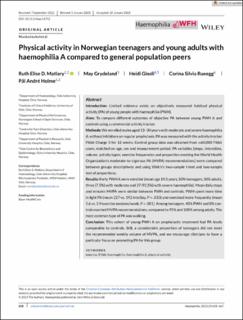| dc.contributor.author | Matlary, Ruth Elise Dybvik | |
| dc.contributor.author | Grydeland, May | |
| dc.contributor.author | Glosli, Heidi | |
| dc.contributor.author | Rüegg, Corina Silvia | |
| dc.contributor.author | Holme, Pål André | |
| dc.date.accessioned | 2023-05-03T19:14:48Z | |
| dc.date.available | 2023-05-03T19:14:48Z | |
| dc.date.created | 2023-02-26T15:08:45Z | |
| dc.date.issued | 2023 | |
| dc.identifier.citation | Haemophilia. 2013, 29(2), Side 658-667. | en_US |
| dc.identifier.issn | 1351-8216 | |
| dc.identifier.uri | https://hdl.handle.net/11250/3066063 | |
| dc.description | This is an open access article under the terms of the Creative Commons Attribution-NonCommercial-NoDerivs License, which permits use and distribution in any medium, provided the original work is properly cited, the use is non-commercial and no modifications or adaptations are made. | en_US |
| dc.description.abstract | Introduction: Limited evidence exists on objectively measured habitual physical activity (PA) of young people with haemophilia (PWH).
Aims: To compare different outcomes of objective PA between young PWH A and controls using a commercial activity tracker.
Methods: We enrolled males aged 13–30 years with moderate and severe haemophilia A, without inhibitors on regular prophylaxis. PA was measured with the activity tracker Fitbit Charge 3 for 12 weeks. Control group data was obtained from ≈60,000 Fitbit users, matched on age, sex and measurement period. PA variables [steps, intensities, volume, activity types, exercise frequencies and proportion meeting the World Health Organization's moderate-to-vigorous PA (MVPA) recommendations] were compared between groups descriptively and using Welch's two-sample t-test and two-sample test of proportions.
Results: Forty PWH A were enrolled (mean age 19.5 years, 50% teenagers, 50% adults, three (7.5%) with moderate and 37 (92.5%) with severe haemophilia). Mean daily steps and minutes MVPA were similar between PWH and controls. PWH spent more time in light PA (mean 227 vs. 192 min/day, P = .033) and exercised more frequently (mean 5.6 vs. 3.9 exercise sessions/week, P < .001). Among teenagers, 40% PWH and 8% controls reached MVPA recommendations, compared to 95% and 100% among adults. The most common type of PA was walking.
Conclusion: This cohort of young PWH A on prophylactic treatment had PA levels comparable to controls. Still, a considerable proportion of teenagers did not meet the recommended weekly volume of MVPA, and we encourage clinicians to have a particular focus on promoting PA for this group. | en_US |
| dc.language.iso | eng | en_US |
| dc.subject | exercise | en_US |
| dc.subject | Fitbit | en_US |
| dc.subject | haemophilia | en_US |
| dc.subject | haemophilia A | en_US |
| dc.subject | physical activity | en_US |
| dc.title | Physical activity in Norwegian teenagers and young adults with haemophilia A compared to general population peers | en_US |
| dc.type | Peer reviewed | en_US |
| dc.type | Journal article | en_US |
| dc.description.version | publishedVersion | en_US |
| dc.rights.holder | © 2023 The Authors | en_US |
| dc.source.pagenumber | 658-667 | en_US |
| dc.source.volume | 29 | en_US |
| dc.source.journal | Haemophilia | en_US |
| dc.source.issue | 2 | en_US |
| dc.identifier.doi | 10.1111/hae.14752 | |
| dc.identifier.cristin | 2129348 | |
| dc.description.localcode | Institutt for fysisk prestasjonsevne / Department of Physical Performance | en_US |
| cristin.ispublished | true | |
| cristin.fulltext | original | |
| cristin.qualitycode | 1 | |


